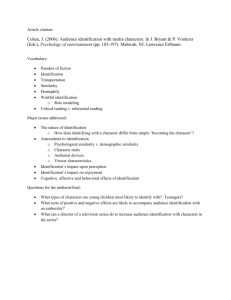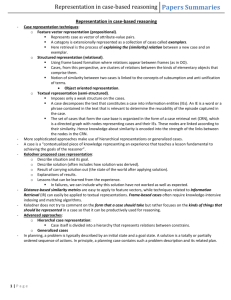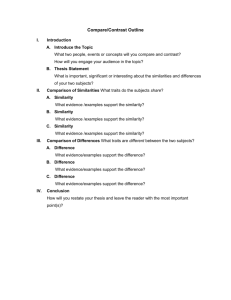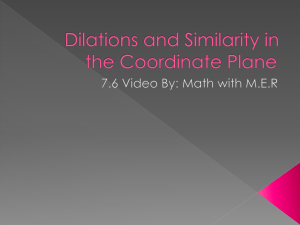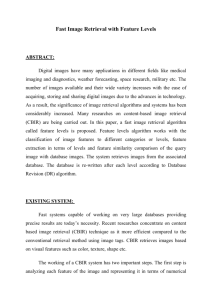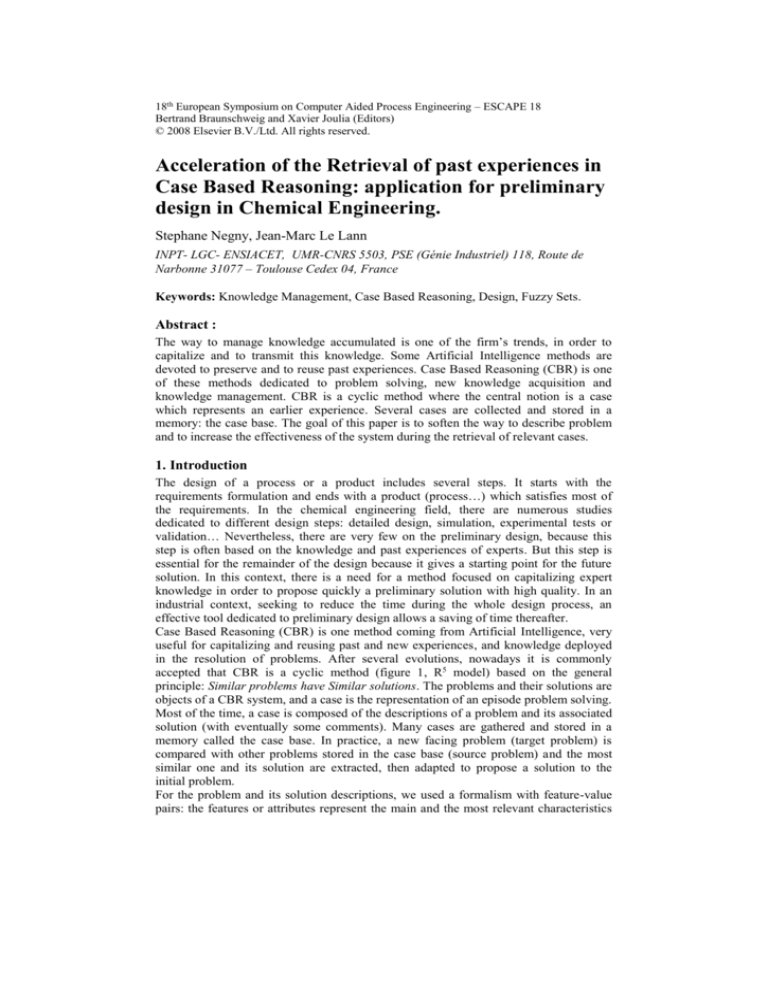
18th European Symposium on Computer Aided Process Engineering – ESCAPE 18
Bertrand Braunschweig and Xavier Joulia (Editors)
© 2008 Elsevier B.V./Ltd. All rights reserved.
Acceleration of the Retrieval of past experiences in
Case Based Reasoning: application for preliminary
design in Chemical Engineering.
Stephane Negny, Jean-Marc Le Lann
INPT- LGC- ENSIACET, UMR-CNRS 5503, PSE (Génie Industriel) 118, Route de
Narbonne 31077 – Toulouse Cedex 04, France
Keywords: Knowledge Management, Case Based Reasoning, Design, Fuzzy Sets.
Abstract :
The way to manage knowledge accumulated is one of the firm’s trends, in order to
capitalize and to transmit this knowledge. Some Artificial Intelligence methods are
devoted to preserve and to reuse past experiences. Case Based Reasoning (CBR) is one
of these methods dedicated to problem solving, new knowledge acquisition and
knowledge management. CBR is a cyclic method where the central notion is a case
which represents an earlier experience. Several cases are collected and stored in a
memory: the case base. The goal of this paper is to soften the way to describe problem
and to increase the effectiveness of the system during the retrieval of relevant cases.
1. Introduction
The design of a process or a product includes several steps. It starts with the
requirements formulation and ends with a product (process…) which satisfies most of
the requirements. In the chemical engineering field, there are numerous studies
dedicated to different design steps: detailed design, simulation, experimental tests or
validation… Nevertheless, there are very few on the preliminary design, because this
step is often based on the knowledge and past experiences of experts. But this step is
essential for the remainder of the design because it gives a starting point for the future
solution. In this context, there is a need for a method focused on capitalizing expert
knowledge in order to propose quickly a preliminary solution with high quality. In an
industrial context, seeking to reduce the time during the whole design process, an
effective tool dedicated to preliminary design allows a saving of time thereafter.
Case Based Reasoning (CBR) is one method coming from Artificial Intelligence, very
useful for capitalizing and reusing past and new experiences, and knowledge deployed
in the resolution of problems. After several evolutions, nowadays it is commonly
accepted that CBR is a cyclic method (figure 1, R5 model) based on the general
principle: Similar problems have Similar solutions. The problems and their solutions are
objects of a CBR system, and a case is the representation of an episode problem solving.
Most of the time, a case is composed of the descriptions of a problem and its associated
solution (with eventually some comments). Many cases are gathered and stored in a
memory called the case base. In practice, a new facing problem (target problem) is
compared with other problems stored in the case base (source problem) and the most
similar one and its solution are extracted, then adapted to propose a solution to the
initial problem.
For the problem and its solution descriptions, we used a formalism with feature-value
pairs: the features or attributes represent the main and the most relevant characteristics
2
S. Negny, J.M. Le Lann
of the problems and solutions. The first step is the filling of the problem attributes for
the target problem (represent). The next step retrieves in the memory one or various
similar cases with the help of a similarity measurement in order to rank them (retrieve).
Because there are some differences between the source and target problems, the source
solution must be adapted to correspond to the target problem (reuse). In the next step
the previous adapted solution is tested and revised to eliminate the discrepancies
between the desired and adapted solutions (revise). Finally, after its resolution, the
target problem and its associated solution form a new case that is retained in the case
base (retain). This is an advantage for this method because the storage of a new
problem increases the effectiveness of the CBR system by enlarging the cover of the
problem space. On the other hand it is also a drawback because by increasing the
number of cases in the memory, the time to retrieve a similar case will be increased too.
The goal of this paper is to help the user during the retrieval of past cases. This
amelioration concerns the retrieved step and can be decomposed in two points: a
method to soften case representation and similarity measurement in one hand, and to
anticipate the adaptation step in the other hand.
Target problem
Represent
New
Case
Retrieve
New
Case
Learned
case
Retain
Reuse
Case base
Validated solution
Retrieved
Case
Solved Case
Revised
and tested
Case
Revise
Figure 1: CBR Cycle
2. Retrieval
2.1. Case Base Organization
The number of cases in the case base is going to grow because of the Retain step or
memorization of new cases. Without case base organization, the cost to estimate the
global similarity between the target problem and all the source cases in the memory
becomes prohibitive. In order to decrease the research time and to increase the
effectiveness of the retrieval, the latter is decomposed in two steps. The first one
consists in selecting a subset of relevant source cases. The second one is dedicated to
the similarity measurement and the ranking of source cases included in the subset. To
select the subset of the more relevant cases for aresearch, we index the case base to
constrain the research space to the nearest source cases. The organization of the memory
is based on the decision tree approach. In this approach, the case base is successively
restricted thanks to decision sequences. All the cases of the base are gathered at a root
node. Starting from this node, intermediate nodes are generated to restrict the number of
case by an evaluation on a discriminate feature. And the end of the tree, at final nodes,
Accelaration of the Retrieval of past experiences in Case Based Reasoning:
Applicationfor preliminary design in Chemical Engineering
3
called the leaves, there are the source cases. Finally in this approach, leaves represent
the classification and branches represent conjunction of features that lead to these
classification. In the tool, the decision tree can be automatically built with an algorithm
based on the ID3 algorithm. Nevertheless, the organization of the case base must reflect
the point of view of the user, therefore he can generate its own decision tree
corresponding to the aim of his retrieval.
2.2. Similarity Measurement
Generally in CBR systems, during the retrieval step, the most relevant case is the most
similar one: the one which has the highest value for the similarity function. The global
similarity between the target problem and some source ones is evaluated by a weighted
sum of the local similarities on each attribute of the problem description.
SIM X , Y
wi sim( xi , y i )
i
(1)
wi
i
µs(x)
µs(x)
1
1
min(f)
max(f)
c
di
ds
dom(f)
min(f)
c1
di
max(f)
c2
ds
dom(f)
Figures 2: Fuzzy Sets representation
In chemical engineering, the attributes for the problem description can contain different
type of values: semantic for the chemical compounds of mixture, and numerical values
for operating condition. For the local similarity of chemical compounds, Avramenko et
al, 2004 proposed an approach based on the chemical structure of compounds which is
implemented in our system. Concerning the local similarity for attributes with
numerical values, the most use formula is to measure the normalized distance (to avoid
distortions of the results when features have different variation scales) between both
source and target values on the same attribute. But during the preliminary design, the
numerical values for the target problem description, are not often precisely known: an
operating condition around a central value for example. Here we take into account this
imprecision in the target problem description by the way of a percentage of imprecision
around the central value specified by the user and a relation, for each attribute. Six
different choices are available for the relation: equ, sup, sup-equ, inf, inf-equ, between
the central value(s). For one attribute ai, the local similarity measurement is achieved
with the fuzzy set theory developed by Zadeh, 1965. We have considered two possible
representations for the fuzzy sets: triangular (for the first five relations) or trapezoidal
(only for the relation between) (figures 2). A fuzzy set S, on a domain D is defined by a
characteristic function μs, which has values in [0;1]. μs(x) indicates the degree to which
x is a possible value in S. With c (or c1 and c2); the central value for ai for the target
problem, the relation coupled with the imprecision allow to build the specific domain S i
4
S. Negny, J.M. Le Lann
(to calculate di and ds). The local similarity for ai is calculated by μsi(zi) where zi is the
value of the source problem attribute corresponding to a i.
2.3. Retrieval Guided by adaptation
The success of any CBR system is contingent on the retrieval of a case that can be
successfully reused to solve the target problem. Consequently, the most similar case is
unwarranted to be the most appropriate from the reuse point of view: it is not
necessarily the easiest to adapt. Sometime, the most similar case may be difficult or
impossible to adapt: technically, in terms of cost... Smyth and Keane, 1998, implement
the idea of coupling the similarity measurement with a deeper adaptation knowledge
traducing the easiness to modify a case to fit the target problem and to ensure case
adaptation requirements. They called this technique: adaptation guided retrieval. With
this technique, the research of source cases is based on two criteria: similarity and
adaptability. Several methods exist to measure this adaptability, but we use the method
proposed by Pralus and Gineste, 2006. For each attribute tsi of the target solution an
adaptation domain is built from the definition domain of the same attribute in the source
solution ssi, figure 3a. The definition domain of ssi is defined by a distribution
possibility, which is specified when the case is retained in the base. The intersection of
this distribution possibility with the relation (coming from the target problem
description, previous part) is projected on the axis of the possible values for tsi, figure
3b. Finally we obtain a distribution of possible values for tsi. We state the assumption
that the shape of this distribution determines the easiness to adapt this attribute. The
more the range is large, the more this attribute is easiest to adapt (more choice to find an
available value for tsi). The concept of specificity introduced by Yager, 1992, measures
the degree to which a fuzzy set contains one and only one element (Specificity=1 for a
very specific fuzzy set, with one value). Consequently the adaptability (adi) of each tsi is
calculated with the measurement of the specificity of its distribution:
adi 1 S p F
with
S p F 0
1
1
d
sup F inf F
(2)
n
And the global adaptability of a case : ad s ad i / n
(3)
i 1
relation
1
1
intersection
0, 8
0, 8
0, 6
0, 4
0, 6
0, 4
projection
0, 2
0, 2
0
tsi
0
0
ssi
distribution of
possibility
0
tsi
ssi
0
0
Figures 3: Graphical representation of the adaptation domain
The user selects source cases with the two criteria and then the adaptation is made with
the method described by Avramenko et al, 2004. This adaptation method is based on the
main idea that the relative distances between the target problem and the selected source
problems in the problem space are transferred in the solution space. To improve
Accelaration of the Retrieval of past experiences in Case Based Reasoning:
Applicationfor preliminary design in Chemical Engineering
5
adaptation, the Constraint Satisfaction Problem (CSP) method will be implemented, and
it will also use the tsi distribution, this is why we choose this adaptability measurement.
3. Example
This example is presented in order to illustrate several parts of the method for the design
of packing for separation. The mixture to separate is a three components distillation
Methanol/Ethanol/Water. The target problem is a column which is operated at finite
reflux, at atmospheric pressure, with feed flow rate between 0.1877 and 0.8123 mol/s.
This distillation corresponds to the work of Mori et al, 2006. Moreover, in our problem
description we impose that the distillation is at atmospheric pressure to exemplify the
option EXACT, to impose a specific value to a feature. In their operating conditions, the
authors do not give the range of temperature, consequently we suppose that it is not
known. Of course, this range can be easily calculated with a thermodynamic analysis of
the mixture at atmospheric pressure. But in order to show how our system treat the
partial description of a problem, we do not fill this feature and we use the option
IGNORE. The first five columns of table 1 sum up the problem description.
Relation
Central Value(s)
Imprecision Ignore
μs Function
Mixture
Pressure
equ
equ
Methanol/Ethanol/Water
1
EXACT
Off
Off
μs
1
z
1
Temperature
Inlet Flow
-between
-0.1877 and 0.8123
-20%
On
Off
1
μs
Rate
z
0.14 0.18
Reflux
equ
4.5
40%
Off
0.81 0.97
μs
1
z
2.7 4.5 6.3
Table 1: Problem description
For the retrieved step, the first work is to build automatically the function μ s for each
numerical feature, except for the temperature because the option IGNORE is activated.
Therefore, this feature is not included in the global similarity calculation. These
functions are represented in the last column of table 1. Before to calculate the global
similarity, the case base is restricted to the subset of the most relevant cases thanks to a
decision tree with the following succession of feature evaluation: at the root node the
evaluation is on the Reflux, then the Pressure, then the Inlet Flow rate. Here again the
temperature is ignored. For each cases in the selected subset, the global similarity
measurement is calculated on four features; compounds, pressure, inlet flow, reflux,
with the same weight for each one.
After the retrieved step, the ranking gives three structured packing (and two random
packing, which are eliminated). The two different Montz-pak B1 are retained for
adaptation. Finally, after adaptation, the proposed target solution is the Montz-pak B1
30, table 2. The second column of table 2 gives the characteristics of the structured
packing used by Mori et al, 2006. In this example, the tools gives a good starting point
for the resolution of the initial problem. It is to notice that the material of the two
retrieved cases selected are: stainless steel (in case 1) and carbon steel (in case 2).
6
S. Negny, J.M. Le Lann
Consequently, for adaptation we search in the subset of metal. Then, the choice is
oriented to the stainless steel because, under operating conditions in the same
magnitude, the mixture of case 1 is most similar to the mixture of the target problem
than the one of case 2. Therefore the choice is made with the following assumption:
under operating conditions in the same magnitude, the most the mixtures are similar, the
most the risk of degradation is reduced. This way to proceed is just a first
approximation, and of course it needs to be improved because this assumption is not
completely satisfactory. The CSP method will be useful for that.
Type of Packing
Material
Specific Area (m2/m3)
Geometrical Characteristics
angle
element height (m)
corrugation height(m)
corrugation base (m)
corrugation side length (m)
Proposed Solution
(Mori et al, 2006) Solution
Structured Packing Montz
pak B1 300
Structured Packing Montz
pak B1 250
Stainless Steel
350
Metal (not specified)
247
45°
0.201
0.008
0.0167
0.0116
45°
0.197
0.012
0.0219
0.016
Table 6: Solution description
4. Conclusion
This paper focuses on the retrieval step in CBR and gives two ways to improve this
step. In one way, it proposes a method to soften case representation by taking into
account some imprecisions during the problem description. It also defines another
criteria to determine if a retrieved case is relevant or not. Most of the time the similarity
is the only criteria to choose a source case. Unfortunately, the most similar case is not
often the most adaptable one. Here the similarity is coupled with an adaptability criteria.
An improvement of our system concerns the next step of the CBR cycle, i.e. adaptation.
Currently there is a general method which gives good results if the retrieved cases are
very near the target problem (like in the presented example). With the adaptability
criteria calculation, we generate the definition range for all the attribute of the target
solution, this is a first step. The second one, is to fix the values of these attributes
(numerical or not) in these intervals, with CSP method. Moreover with this method
some constraints would be added like: user preferences, technical constraints…
References
Avramenko Y., Nyström L., Kraslawski A., 2004, Selection of internals for reactive distillation
column – case based reasoning approach, Comp. and Chem.Eng., 28, 37-44.
Pralus M., Gineste L., 2006, Recherche et adaptation d’expériences structutrées, imprécises et
incomplètes, Raisonnement à Partir de Cas 1, Hermes, 65-93.
Mori H., Ibuki R., Taguchi K., Futuma K., Olujic Z., 2006, Three-component distillation using
structured packing: performance evaluation and model validation, Chem. Eng. Sci., 61, 17601766
Smyth B., Kean M. T., 1998, Adaptation-guided retrieval: questioning the similarity assumption
in reasoning, Artificial Intelligence, 102, 249-293.
Yager R.R., 1992, On the specificity of a possibility distribution, Fuzzy Stes and Systems, 50,
179-292.
Zadeh L.A., 1965, Fuzzy sets, Information and Control, 8, 338-353.

